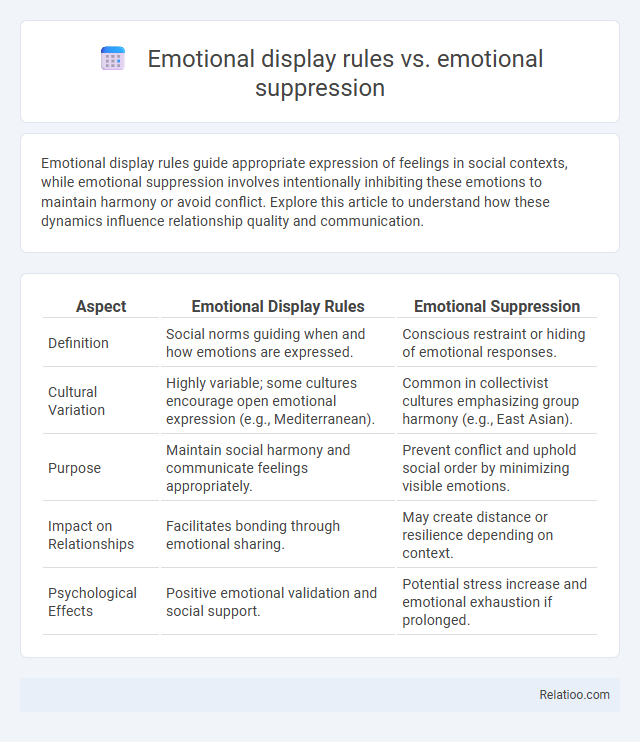Emotional display rules guide appropriate expression of feelings in social contexts, while emotional suppression involves intentionally inhibiting these emotions to maintain harmony or avoid conflict. Explore this article to understand how these dynamics influence relationship quality and communication.
Table of Comparison
| Aspect | Emotional Display Rules | Emotional Suppression |
|---|---|---|
| Definition | Social norms guiding when and how emotions are expressed. | Conscious restraint or hiding of emotional responses. |
| Cultural Variation | Highly variable; some cultures encourage open emotional expression (e.g., Mediterranean). | Common in collectivist cultures emphasizing group harmony (e.g., East Asian). |
| Purpose | Maintain social harmony and communicate feelings appropriately. | Prevent conflict and uphold social order by minimizing visible emotions. |
| Impact on Relationships | Facilitates bonding through emotional sharing. | May create distance or resilience depending on context. |
| Psychological Effects | Positive emotional validation and social support. | Potential stress increase and emotional exhaustion if prolonged. |
Understanding Emotional Display Rules
Understanding emotional display rules involves recognizing culturally and socially prescribed norms that dictate how emotions should be expressed or concealed in various contexts. These rules guide individuals on appropriate emotional expression, balancing emotional expression and emotional suppression to maintain social harmony. Emotional display rules vary across cultures and settings, influencing whether emotions are openly shown, modified, or withheld to align with social expectations.
Defining Emotional Suppression
Emotional suppression refers to the conscious inhibition or concealment of emotional responses to conform to social norms or personal goals. Unlike emotional expression, which involves openly showing feelings, suppression limits outward signs of emotion to maintain composure or avoid conflict. Emotional display rules are culturally derived guidelines dictating when and how emotions should be expressed, often encouraging suppression in specific contexts.
Cultural Influences on Emotional Expression
Cultural influences significantly shape emotional display rules, dictating when, where, and how emotions should be expressed or suppressed in social settings. Emotional suppression often aligns with collectivist cultures that prioritize group harmony, while emotional expression tends to be more accepted in individualistic societies valuing personal authenticity. Understanding these cultural variations is essential for effective cross-cultural communication and emotional intelligence development.
Psychological Impacts of Display Rules
Emotional display rules dictate societal expectations about which emotions can be openly shown, influencing your psychological well-being by regulating emotional expression. Emotional suppression, the conscious inhibition of feelings contrary to these rules, often leads to increased stress, anxiety, and decreased emotional authenticity. In contrast, healthy emotional expression aligned with display rules promotes emotional regulation, social connectedness, and psychological resilience.
Health Consequences of Emotional Suppression
Emotional suppression, the conscious inhibition of emotional expression, often leads to increased physiological stress and weakened immune function, contributing to chronic health issues such as hypertension and cardiovascular disease. Unlike emotional expression, which promotes psychological well-being and social connectivity, suppression is linked to higher rates of anxiety, depression, and impaired cognitive processing. Understanding the health consequences of emotional suppression highlights the importance of emotional display rules that encourage healthy and adaptive emotional expression.
Social Outcomes of Expressing vs. Suppressing Emotions
Emotional display rules guide how emotions should be expressed or suppressed in social contexts, affecting interpersonal relationships and social cohesion. Expressing emotions authentically can enhance trust, empathy, and social support, improving Your social bonds and psychological well-being. Conversely, emotional suppression may prevent conflict but often leads to increased stress, reduced social connectedness, and potential misunderstandings in social outcomes.
Emotional Intelligence and Regulation Strategies
Emotional display rules dictate culturally influenced guidelines on when and how emotions should be expressed, impacting emotional intelligence by shaping one's ability to interpret and manage interpersonal cues effectively. Emotional suppression involves consciously inhibiting emotion expression, often leading to increased cognitive load and reduced social connection, while emotional expression allows for authentic communication and emotional release, enhancing emotional regulation strategies. Mastery of distinguishing and applying these concepts improves emotional intelligence by promoting adaptive regulation techniques that balance expression and control in varied social contexts.
Workplace Implications of Emotional Management
Emotional display rules in the workplace guide employees on appropriate emotional expressions, shaping interactions and maintaining professionalism. Emotional suppression can reduce immediate conflict but often leads to increased stress, decreased job satisfaction, and impaired mental health for you. Encouraging authentic emotional expression fosters trust, enhances communication, and promotes a positive organizational culture that supports employee well-being and productivity.
Navigating Emotional Authenticity and Social Expectations
Emotional display rules dictate the socially acceptable ways to express feelings in different contexts, guiding how your emotions align with cultural norms. Emotional suppression involves consciously inhibiting authentic feelings to comply with these expectations, potentially impacting mental well-being. Balancing emotional expression with social expectations allows you to navigate authenticity while maintaining social harmony and personal integrity.
Balancing Display Rules and Personal Well-being
Balancing emotional display rules and personal well-being requires recognizing the impact of emotional suppression on mental health. Emotional display rules guide appropriate expression in social contexts, but consistently suppressing emotions can lead to stress and decreased psychological resilience. Understanding your emotional expression helps manage these rules effectively, promoting authenticity while maintaining emotional equilibrium.

Infographic: Emotional display rules vs Emotional suppression
 relatioo.com
relatioo.com